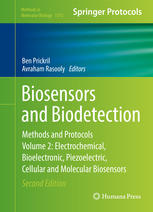

Most ebook files are in PDF format, so you can easily read them using various software such as Foxit Reader or directly on the Google Chrome browser.
Some ebook files are released by publishers in other formats such as .awz, .mobi, .epub, .fb2, etc. You may need to install specific software to read these formats on mobile/PC, such as Calibre.
Please read the tutorial at this link: https://ebookbell.com/faq
We offer FREE conversion to the popular formats you request; however, this may take some time. Therefore, right after payment, please email us, and we will try to provide the service as quickly as possible.
For some exceptional file formats or broken links (if any), please refrain from opening any disputes. Instead, email us first, and we will try to assist within a maximum of 6 hours.
EbookBell Team

4.7
106 reviewsThis volume provides comprehensive and detailed technical protocols on current biosensor and biodetection technologies and examples of their applications and capabilities. Chapters in Biosensors and Biodetection: Methods and Protocols Volume 2,Electrochemical, Bioelectronic, Piezoelectric, Cellular and Molecular Biosensors,Second Edition focus on electrochemical biosensors including amperometric, impedance and voltammetric sensors, bioelectronic, piezoelectric, cellular, and molecular biosensors. Written in the highly successful Methods in Molecular Biology series format, chapters include introductions to their respective topics, lists of the necessary materials and reagents, tips on troubleshooting and avoiding known pitfalls, and step-by-step, readily reproducible laboratory protocols.
Authoritative and practical, Biosensors and Biodetection: Methods and Protocols Volume 2:Electrochemical, Bioelectronic, Piezoelectric, Cellular and Molecular Biosensors, Second Edition offers descriptions of major technologies by leading experts in the field in extensive technical detail. The aim of the book is to make biosensors more accessible and understandable to engineers, students, medical professionals, molecular biologists, chemical, and physical science researchers developing biosensor technologies, allowing readers to both understand the technology and to construct similar devices.